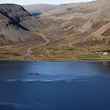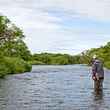Until 1990, when congress passed the Tongass Timber Reform Act and changing market conditions forced the highly government subsidized logging companies in the Tongass to halt operations, the Tongass National Forest was the site of numerous large scale logging operations that clear cut old growth timber stands at the peril of the region's natural habitats and tourism industries. In 2010, the US Forest Service pledged a major course correction in management principles, one which would focus on young-growth timber and supporting job creation in existing industries such as fishing, seafood processing, mariculture, tourism, visitor services and alternative energy.
Alaska's tourism and fishing industries are both on the rise. Southeast Alaska is home to the largest workforce in Alaska's fishing and seafood industry and in 2012, the waters that surround the Tongass National Forest saw the most lucrative salmon harvests in the entire state. Cruise ship and tourist visitation have returned to previous high levels. Southeast Alaska's population of children and students are on the rise for the first time in decades.
Despite these apparent bright spots, Alaska Governor Sean Purnell, Senator Lisa Murkowski and state forestry officials are calling for a return to forest management philosophies of the 1950s, which saw massive stands of old growth Tongass forest land opened to two industrial logging companies, with long term 50-year contracts in place. The era that followed -- until both companies closed up shop in the early 1990s -- was one characterized by recalcitrant pollution, timber price fixing and severe habitat degradation and destruction.
According to a press release by Trout Unlimited and the Sitka Conservation Society, "Murkowski addressed the Senate Energy and Natural Resources Committee during an oversight hearing on forest management. In her opening remarks, Murkowski blamed the decline of the Southeast Alaska timber industry on federal policies, environmental lawsuits and stringent regulations, ignoring the fact that for decades the Tongass timber program operated at unsustainable levels and was only able to maintain itself with massive government subsidies. She implied that if only the Forest Service increased the amount of clear-cut logging allowed on the Tongass, the timber industry could return to its former past when two large pulp mills consumed vast volumes of the Tongass’ rare old-growth trees."
Tim Bristol, director of Trout Unlimited's Alaska program, noted that "“this is disturbing rhetoric. It’s hard to believe the senator is this out of touch with what is going on in Southeast."
Supporting Murkowski was Alaska State Forester Chris Maisch, who recommended the transfer of two million acres of federal land to the State of Alaska, with logging the primary and driving force of that land's management by the state.
“The last thing Southeast Alaska needs is a return to a massive old-growth logging program in the Tongass National Forest. Our region’s economy is sustained by a healthy forest that produces tens of millions of wild salmon every year, employing more than 7,200 people in a billion-dollar salmon fishing industry. Our economy is also fueled by tourism, an industry with more than 10,000 jobs that depends on beautiful scenery in its natural state, not unsightly clear cuts,” said Andrew Thoms, executive director of the Sitka Conservation Society.
The press release went on to state that "despite the promising statement from three years ago, the Forest Service has yet to make good on its transition pledge. Funding for visitor services, recreation and forest restoration is inadequate and the agency continues to focus its budget and staff resources on old-growth timber planning. It has 130 million board feet of Tongass old-growth under contract to cut and is planning to sell another 600 million board feet over the next five years. In his testimony on Tuesday, Forest Service Chief Tom Tidwell noted that a 100 million board foot timber sale, dubbed Big Thorne, is expected to be released soon. It would be the largest-volume old-growth timber sale in the Tongass since the pulp mill days, said Bristol."
The comments made by Senator Murkowski and other officials come on the heels of a Senate Energy and Natural Resources Committee vote in favor of transferring 70,000 acres of Tongass forest land to privately held native Sealaska Corporation, a company with a history of clear cutting old growth timber. This proposed transfer, backed by Alaskan lawmakers such as Murkowski, has been strongly opposed by environmental groups, commercial fishermen and indigenous Alaskans that rely on healthy, sustainable Tongass ecosystems.































Comments